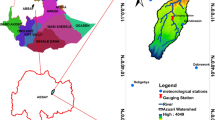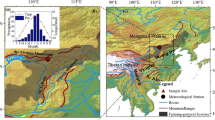Abstract
Historical aerial photography over closed basins enables the observation of lake surfaces at variable water levels and climatic conditions. Thus, the assessment at the landscape level of subtle variations in inundated areas depends on a suitable framework for processing historical imagery, frequently available at different scales and resolutions.
The present paper deals with Lake Patzcuaro as a case study and the application of three analytical procedures to remote sensed data of 1974, including two maps commercially available and nine aerial photographs. Computer-based processing of images and further incorporation into GIS led to three different outputs: topographic map (TM-GIS), photomosaic 1 (P1) and photomosaic 2 (P2). Aerial photographs assemblages were georeferenced by means of GCP's, 86 located by means of INEGI vectorial polygons (P1), and 40 determined directly at the field by GPS (P2).
In conclusion, TM-GIS lack of photointerpretation for the lake as an image derived from a topographic map; while P2 involved an unacceptable RMS. P1 thus became the best option for the calculation of areas not only because of the lower RMS associated, but the additional photointerpretation of limnological zones exclusive to aerial photographs. As a background picture, P1 also facilitates the analysis of historical images on a comparative basis.
Similar content being viewed by others
References
Bernal-Brooks, F. W. & H. R. MacCrimmon, 2000. Lake Zirahuen (Mexico): an assessment of morphometry change based on evidence of water level fluctuations and sediment inputs. In Munawar, M., S. Lawrence, I. F. Munawar & D. Malley (eds), Aquatic Ecosystems of Mexico: Status & Scope. Backhuys, The Netherlands: 61–76.
Bernal-Brooks, F. W., A. Gomez-Tagle Rojas & J. Alcocer, 2002. Lake Patzcuaro (Mexico): a controversy about the ecosystem water regime approached by field references, climatic variables, and GIS. Hydrobiologia 467 (Dev. Hydrobiol. 163): 187–197.
Birkett, C. M. & I. A. Mason, 1995. A new global lakes database for a remote sensing programme studying climatically sensitive large lakes. J. of Great Lakes Research 21: 307–318.
CETENAL (Centro de Estudios para el Territorio Nacional), 1977. Topographic charts E14A21 and E14A22 (1:50 000). 3rd edn.
Chacon, A., L. G. Ross & M. C. M. Beveridge, 1989. Lake Patzcuaro, Mexico: results of a new morphometric study and its implications for productivity assessments. Hydrobiologia 184: 125–132.
De Buen, F., 1944. Los lagos michoacanos. II. El Lago de Pátzcuaro. Rev. Soc. Mex. Hist. Nat. 5: 99–125.
Fritz, S. C., B. F. Cumming, F. Gasse & K. Laird, 1999. In Stoermer, E. F. & J. P. Smol (eds), The Diatoms. Applications for the Environmental and Earth Sciences. Cambridge University Press, Cambridge: 41–72.
García, E., 1988. Modificaciones al sistema climático de Köppen. Talleres de offset Larios, S.A., México, D.F: 217 pp.
Herrera, E., 1979. Características y manejo del Lago de Pátzcuaro, Michoacán. BSc thesis. National University of Mexico (UNAM). Mexico.
Hudak, A. T. & C. A. Wessman, 1998. Textural analysis of historical aerial photography to characterize woody plant encroachment in South African Savanna. Remote Sens. Environ. 66: 317–330.
Johnson, L. B. & S. H. Gage, 1997. Landscape approaches to the analysis of aquatic ecosystems. Fresh wat. Biol. 37: 113–132.
Kadman, R. & R. Harari-Kremar, 1999. Studying long-term vegetation dynamics using digital processing of historical aerial photographs. Remote Sens. Environ. 68: 164–176.
Meaden, G. J. & J. M. Kapetsky, 1992. Los sistemas de información geográfica y la telepercepción en la telepercepción en la pesca continental y la acuicultura. FAO technical Report no. 318: 266 pp.
Miller, M. E., 1999. Use of historic aerial photography to study vegetation change in the Negrito CreekWatershed, Southwestern New Mexico. The Southwestern Naturalist 44: 121–137.
SMN (Servicio Meteorológico Nacional), 1922-1986. Climatic variables registered at 16087 Meteorological Station.
Tellez, R. & O. Motte, 1980. Estudio planctonológico preliminar del Lago de Pátzcuaro, Michoacán, México. Mayo de 1976. 2nd. Latinamerican Symposium of Aquaculture: 1797–1836.
Velasco, A., 1982. Evaluación de la calidad del agua con base en algunos aspectos de la comunidad planctónica del Lago de Pátzcuaro, Michoacán. BSc thesis. National University of Mexico (UNAM), Mexico.
Zozaya, M., 1940a. Informes de la Estación Limnológica de Pátzcuaro. Mayo 1940: 14 pp.
Zozaya, M., 1940b. Informes de la Estación Limnológica de Pátzcuaro. Junio 1940: 14 pp.
Author information
Authors and Affiliations
Rights and permissions
About this article
Cite this article
Gomez-Tagle Chavez, A., Bernal-Brooks, F. & Alcocer, J. Sensitivity of Mexican water bodies to regional climatic change: three study alternatives applied to remote sensed data of Lake Patzcuaro. Hydrobiologia 467, 169–176 (2002). https://doi.org/10.1023/A:1014962831319
Issue Date:
DOI: https://doi.org/10.1023/A:1014962831319




